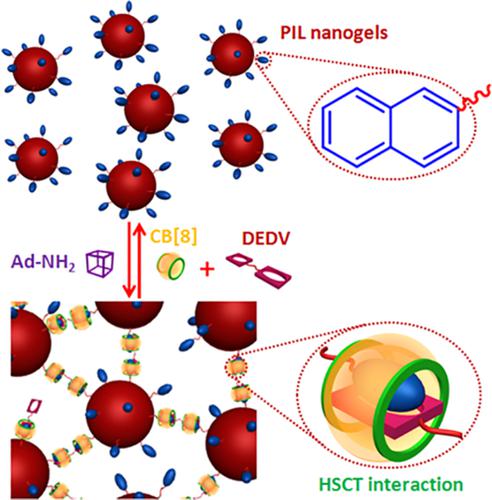当前位置:
X-MOL 学术
›
J. Polym. Sci. A Polym. Chem.
›
论文详情
Our official English website, www.x-mol.net, welcomes your feedback! (Note: you will need to create a separate account there.)
Supramolecular assembly of poly(ionic liquid) nanogel driven by host‐stabilized charge transfer interaction
Journal of Polymer Science Part A: Polymer Chemistry ( IF 2.869 ) Pub Date : 2019-10-23 , DOI: 10.1002/pola.29516 Yuntao Tang 1 , Ke Wang 1 , Yong Zuo 2 , Xi Chen 2 , Yubing Xiong 1, 2 , Yumin Yuan 1
Journal of Polymer Science Part A: Polymer Chemistry ( IF 2.869 ) Pub Date : 2019-10-23 , DOI: 10.1002/pola.29516 Yuntao Tang 1 , Ke Wang 1 , Yong Zuo 2 , Xi Chen 2 , Yubing Xiong 1, 2 , Yumin Yuan 1
Affiliation

|
Poly(ionic liquid) (PIL)‐based nanogels, functionalized by naphthyl (Np), are fabricated via a facile one‐step ternary crosslinking copolymerization in selective solvent. The size of PIL nanogels can be conveniently regulated through the feed ratio of IL monomer to crosslinker. The presence of Np groups in PIL nanogel is confirmed by using ultraviolet–visible (UV–vis), Fourier transform infrared, and X‐ray photoelectron spectroscopy measurements. Through introducing cucurbit[8]uril (CB[8]) and bisviologen compound (DEDV) as the host molecule and electron acceptor, respectively, host‐stabilized charge transfer (HSCT) interaction is achieved through utilizing Np containing PIL nanogel as the building block. The studies reveal that PIL nanogels can form schistose aggregates in the scale of micrometer via HSCT interaction. The aggregates will be broken in the presence a competitive guest molecule (amantadine) and can recover by adding another host molecule (CB[7]). HSCT interaction among CB[8], DEDV and PIL nanogel is investigated by dynamic light scattering, UV–vis, and Proton nuclear magnetic resonance. Our studies thus provided an applicable strategy for constructing dynamic polymer nanoparticles through noncovalent interaction. © 2019 Wiley Periodicals, Inc. J. Polym. Sci., Part A: Polym. Chem. 2019, 57, 2251–2259
中文翻译:

主体稳定的电荷转移相互作用驱动的聚离子液体纳米凝胶的超分子组装
通过萘基(Np)功能化的基于聚(离子液体)(PIL)的纳米凝胶是通过在选择性溶剂中进行的简便的一步三元交联共聚而制得的。可以通过IL单体与交联剂的进料比例方便地调节PIL纳米凝胶的大小。通过使用紫外可见光(UV-vis),傅里叶变换红外光谱和X射线光电子能谱测量,可以确认PIL纳米凝胶中Np基团的存在。通过分别引入葫芦[8]尿素(CB [8])和双紫罗兰化合物(DEDV)作为主体分子和电子受体,利用含Np的PIL纳米凝胶作为结构单元,实现了主体稳定的电荷转移(HSCT)相互作用。 。研究表明,PIL纳米凝胶可通过HSCT相互作用在微米级形成片状聚集体。在存在竞争性客体分子(金刚烷胺)的情况下,聚集体将被破坏,并且可以通过添加另一种宿主分子(CB [7])来恢复。通过动态光散射,UV-vis和质子核磁共振研究了CB [8],DEDV和PIL纳米凝胶之间的HSCT相互作用。因此,我们的研究为通过非共价相互作用构建动态聚合物纳米粒子提供了适用的策略。分级为4 +©2019 Wiley Periodicals,Inc.J.Polym。科学,A部分:Polym。化学 因此,我们的研究为通过非共价相互作用构建动态聚合物纳米粒子提供了适用的策略。分级为4 +©2019 Wiley Periodicals,Inc.J.Polym。科学,A部分:Polym。化学 因此,我们的研究为通过非共价相互作用构建动态聚合物纳米粒子提供了适用的策略。分级为4 +©2019 Wiley Periodicals,Inc.J.Polym。科学,A部分:Polym。化学2019,57,2251年至2259年
更新日期:2019-10-23
中文翻译:

主体稳定的电荷转移相互作用驱动的聚离子液体纳米凝胶的超分子组装
通过萘基(Np)功能化的基于聚(离子液体)(PIL)的纳米凝胶是通过在选择性溶剂中进行的简便的一步三元交联共聚而制得的。可以通过IL单体与交联剂的进料比例方便地调节PIL纳米凝胶的大小。通过使用紫外可见光(UV-vis),傅里叶变换红外光谱和X射线光电子能谱测量,可以确认PIL纳米凝胶中Np基团的存在。通过分别引入葫芦[8]尿素(CB [8])和双紫罗兰化合物(DEDV)作为主体分子和电子受体,利用含Np的PIL纳米凝胶作为结构单元,实现了主体稳定的电荷转移(HSCT)相互作用。 。研究表明,PIL纳米凝胶可通过HSCT相互作用在微米级形成片状聚集体。在存在竞争性客体分子(金刚烷胺)的情况下,聚集体将被破坏,并且可以通过添加另一种宿主分子(CB [7])来恢复。通过动态光散射,UV-vis和质子核磁共振研究了CB [8],DEDV和PIL纳米凝胶之间的HSCT相互作用。因此,我们的研究为通过非共价相互作用构建动态聚合物纳米粒子提供了适用的策略。分级为4 +©2019 Wiley Periodicals,Inc.J.Polym。科学,A部分:Polym。化学 因此,我们的研究为通过非共价相互作用构建动态聚合物纳米粒子提供了适用的策略。分级为4 +©2019 Wiley Periodicals,Inc.J.Polym。科学,A部分:Polym。化学 因此,我们的研究为通过非共价相互作用构建动态聚合物纳米粒子提供了适用的策略。分级为4 +©2019 Wiley Periodicals,Inc.J.Polym。科学,A部分:Polym。化学2019,57,2251年至2259年



























 京公网安备 11010802027423号
京公网安备 11010802027423号